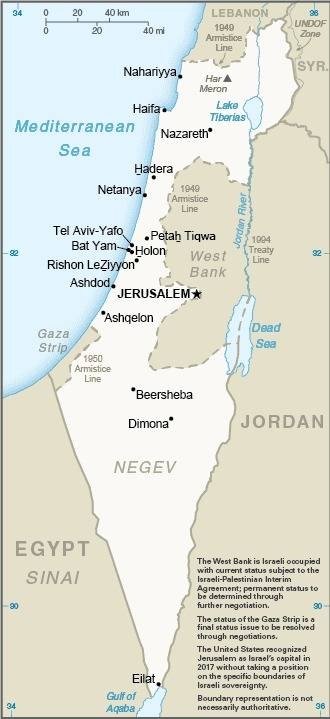144 Israel

White with a blue hexagram (six-pointed linear star, a Jewish symbol dating back to medieval times) known as the Magen David (Star of David or Shield of David) centered between two equal horizontal blue bands near the top and bottom edges of the flag. The basic design resembles a traditional Jewish prayer shawl (tallit), which is white with blue stripes.
Flag courtesy of the CIA World Factbook

Map courtesy of the CIA World Factbook

A nighttime view of Jerusalem and Israeli-occupied East Jerusalem, taken from the Mount of Olives.
Photo courtesy of the CIA World Factbook
Government
According to Britannica, Israel does not have a formal written constitution. Instead, its system of government is founded on a series of “basic laws” plus other legislation, executive orders, and parliamentary practice. The basic laws are a political compromise that serve as an alternative to a constitution. They are passed in the same way as other pieces of legislation but are intended to serve as guiding principles of the state. While it remains unclear whether the basic laws in fact hold superiority over other laws, Israel’s High Court of Justice has historically ruled against laws that have contradicted the basic laws.
The country is a democratic republic with a parliamentary system of government headed by a prime minister and involving numerous political parties representing a wide range of political positions. Israel’s lawmaking body, the Knesset, or assembly, is a single-chamber legislature with 120 members who are elected every four years (or more frequently if a Knesset vote of non confidence in the government results in an early election). Members exercise important functions in standing committees. Hebrew, the country’s official language, and Arabic, legally recognized as holding special status, are used in all proceedings.
The country’s prime minister is the head of government and is entrusted with the task of forming the cabinet, which is the government’s main policy-making and executive body. Israel has a strong cabinet, and its members may be, but need not be, members of the Knesset.
The president, who is the head of state, was traditionally elected by the Knesset for a five-year term that could be renewed only once; beginning in 2000, however, presidents were elected for a single, seven-year term. The president has no veto powers and exercises mainly ceremonial functions but has the authority to appoint certain key national officials, including state comptroller, governor of the Bank of Israel, judges, and justices of the Supreme Court.
The state comptroller, an independent officer elected by the Knesset before being appointed by the president, is responsible only to the Knesset and is the auditor of the government’s financial transactions and is empowered to inquire into the efficiency of its activities. The comptroller also acts as a national ombudsman.
Israel’s civil service gradually has become a politically neutral and professional body; previously, it tended to be drawn from, and to support, the party in power. The government’s extensive responsibilities and functions have acted to enlarge the bureaucracy.
The country is divided into 6 districts, Central, Jerusalem, Haifa, Northern, Southern, and Tel Aviv, and into 15 subdistricts. Local government consists of municipalities, local councils (for smaller settlements), or regional rural councils. The bylaws of the councils, as well as their budgets, are subject to approval by the Ministry of the Interior. Local government elections are held every five years.
Civil / National Aviation Authority (CAA/NAA)
The Civil Aviation Authority of the state of Israel is primarily responsible for the regulation of the civil aviation in the State of Israel in compliance with the Air Navigation rules, standards and International Conventions.
Airspace
SkyVector – Google Maps – ADS-B Exchange
ICAO countries publish an Aeronautical Information Publication (AIP). This document is divided into three parts: General (GEN), En Route (ENR) and Aerodromes (AD). ENR 1.4 details the types of airspace classes they chose to adopt from classes A through G. Israel AIP


Drone Regulations
The field of unmanned aerial vehicles (UAVs) under the general and sports aviation department in the air control division.
The department provides service to the public in the following areas:
- UAV pilot permits
- UAV instructor permits
- Licensing of companies engaged in work using UAVs
- Importing airplanes and UAVs
And any additional information in this area is believed by the Civil Aviation Authority.
Confirmation of the absence of criminal convictions and a security assessment for applicants for the pilot profession
In order to complete the conditions for obtaining a pilot’s license, you must obtain a certificate of absence of criminal convictions and a security clearance from the safety officer of the Ministry of Transportation. On this page you will find the information required to obtain these permits
Consent form to receive information about criminal convictions online
Application form for a security assessment for candidates for aviation professions
Before Starting – One of the conditions for obtaining a pilot’s license is the absence of criminal convictions (see the provisions of Regulation 12 of the Pilot Regulations (Licenses for Pilot Employees), 1981) (hereinafter – the “License Regulations”), confirmation of the absence of criminal convictions is obtained from the criminal registry managed by the Israel Police.
Since information from the criminal database is personal information of the applicant for the pilot’s license, the consent of the applicant is required for the production of the information by the Israel Police and its delivery to the Civil Aviation Authority (CAA).
Receiving the approval – In order for the Civil Aviation Authority to be entitled to request the information required for approval, you are asked to fill out the online form in which you express your consent that the information will be handed over to the Civil Aviation Authority.
More information about the lack of criminal convictions – A criminal conviction for one of the offenses listed in Part A of the Sixth Supplement of the License Regulations may prevent the possibility of obtaining a pilot’s license . the license requested by him. The period is determined by the type of offense:
-
- Felony – five years
- Misdemeanor offense – three years
- Misdemeanor offense – one year.
Under certain conditions, it is possible to shorten half of the prevention period for obtaining a license, according to RTA’s discretion.
RTA may not issue a license or air crew member certificate in cases where there are pending cases against the license applicant and this after consultation with the Investigations and Prosecutions Department of the Israel Police.
Security assessment for candidates for pilot professions – Any request to issue a license must receive the security approval of the security officer of the Ministry of Transportation.
In order to receive the approval, you must fill out an online form that constitutes your approval to perform a security assessment. To receive an identified government service you will be required to go through a one-time process of registration and identity verification.
Please note – the form is only supported in Chrome, Firefox and Safari browsers. In cases where there is no access to an online form, an application can be submitted through the schools. In cases where your request was not approved, you may appeal the decision before the Security and Aviation Appeals Committee.
Do not fly in the following cases:
- Airplanes are prohibited from flying in the areas specified in the publication of aviation information .
- At a height exceeding 50 meters.
- At a distance of less than 250 meters from a residential neighborhood, a public building such as a school, hospital, cinema, etc. or a place of gathering of people.
- in the area of an airport or airstrip control area.
- in an area of less than 2 kilometers from any point of the route.
- At a distance of less than 500 meters from the area of a training area intended for small planes.
It is recommended to check the need for a license for commercial operation before starting the study and licensing process. Learning to fly Rav Lahav for commercial purposes can be done at any company that has completed the commercial licensing process with the Civil Aviation Authority (RATA). Rav Lahav is an unmanned radio-controlled motorized aircraft, used or intended to be used for sports and leisure purposes.
If the use of the aircraft (Rav Lahav) is or is intended to be used for commercial or general purposes (for remuneration or for professional use at work), then the definition becomes “aircraft” to which all regulations of the Aviation Law apply.
A UAV is an “unmanned aerial vehicle”. Controlled by radio communication by a ground station, its size can range from a few hundred grams to hundreds of kilograms, and flying it involves obtaining a pilot’s license that corresponds to its weight and definition.
Flying a UAV involves obtaining appropriate permits from the air traffic control unit, and it is treated as an aircraft.
- A theory test must be performed for a pilot with a hand-held blade – the test includes questions on the constitution of unmanned aerial vehicles (UAVs), meteorology, and general technical knowledge.
- For a permit to fly a multi-bladed aircraft whose take-off weight does not exceed 4 kg – the applicant must send a statement in which he signs that he has undergone regular training with an air operator’s license holder. The air operator’s license holder who performed the training must also sign the same statement. This means that the holder of the air operator’s license declares that the training was carried out according to the training plan approved by the Civil Aviation Authority (RATA) in the operational handbook of the air operator, and is responsible for the level of flying of the license applicant. Link to statement
- Medical certificate – Applicants for small blade pilot’s permit will be required to sign a health declaration instead of the medical certificate.
- In order to obtain a permit to fly a multi-bladed aircraft weighing more than 4 kg and up to 25 kg – a practical test must be passed on the requested instrument. The applicant to receive a permit of this type will contact the licensing department to receive an application for the test, a fee to be paid and he will be able to be tested. The test will be performed on a multi-blade over 4 kg, legally registered and with a tail number.
It must be remembered that in order to carry out commercial work, the pilot’s permit is not enough, a complete process of commercial licensing of a company must be carried out.
To coordinate a theory test, a proof of payment of a theory test fee must be sent to the Aviation Workers Licensing Division by e-mail at the address: Ratatais@mot.gov.il .
After paying the fee, you must set a date for the requested test through the MyVisit website or app and choose a “RATA” service provider. Please note, a test scheduled without paying a fee will be automatically canceled.
You can cancel a theory test up to 10 days from the date of the test, via the MyVisit website or app.
Advanced Air Mobility (AAM)
Short Essay Questions
Question 1
You have been hired by a Drone Startup Company. Your boss has immediately assigned this job to you.
They need you to prepare a one-page memo detailing the legalities of using a drone to film at night in Jerusalem, pictured above.
They need you to mention any national laws and local ordinances.
They specifically want to know what airspace you will be operating in and whether or not you need an airspace authorization.
Does it matter whether or not you are a citizen of the country?
Lastly, there is a bonus for you if, as you scroll through this chapter, you find any typos or broken links!
Question 2
Do you need a certificate to fly UAS?
If so, how do you obtain one?
Are there fees associated with this?
If so, how much?
Question 3
May you operate beyond visual line of sight?
If so, what procedures must you follow?
Question 4
Does the country have UAM/AAM laws? If so, describe, citing the exact law.
Question 5
Are you aware of any new laws or policies not mentioned above? If so, describe, citing the exact law or policy.

